Antec Three Hundred Two: Stay Cool, Budget Enthusiasts
by Dustin Sklavos on January 24, 2012 7:00 AM EST- Posted in
- Cases/Cooling/PSUs
- Antec
- mid-tower
Noise and Thermal Testing, Overclocked
Antec's Three Hundred Two put in a solid showing in our stock settings, but as you'll see, it's under the increased thermal load from our overclocked testbed that it really starts to come into its own. This is why enthusiasts on a budget will want to take note: long, long ago overclocking was about maximizing bang for your buck, and that's what Antec is aiming to do here.
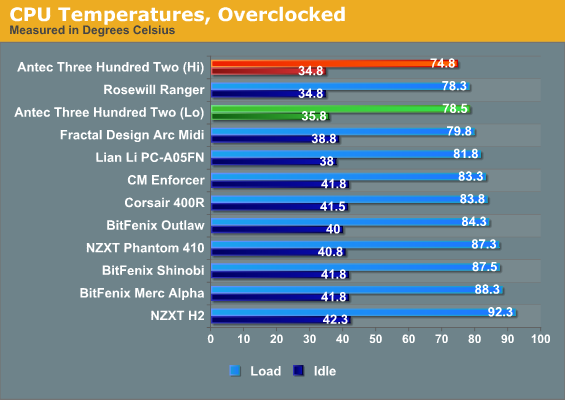

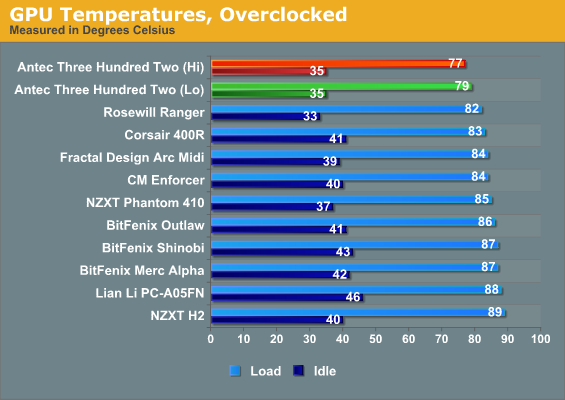
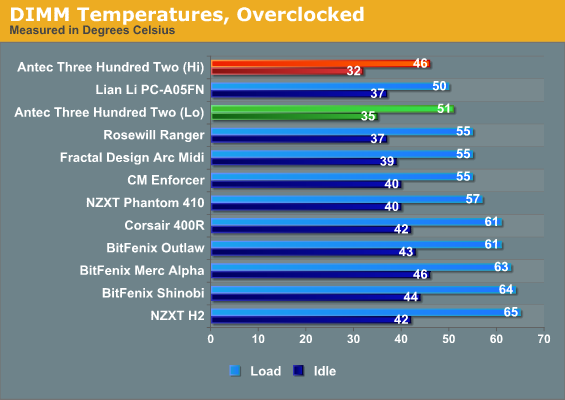
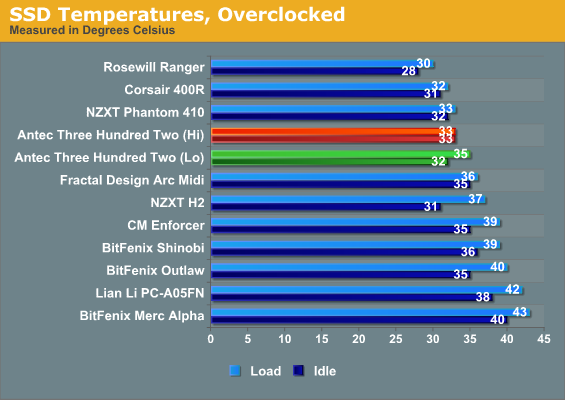
It's very nearly a clean sweep for Antec. The low fan speed continues to do a good job of keeping thermals down and idle CPU and GPU temps are among the best we've seen. The only test where the Antec doesn't place quite as high on the charts is in SSD temperatures, but anything south of 40C is more than adequate.
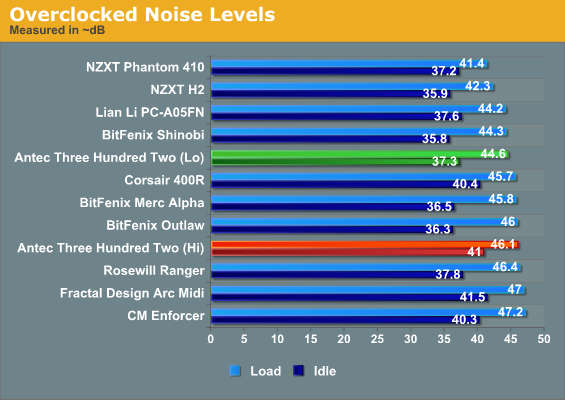
Of course, that performance comes at a cost. While idle noise isn't that bad at the low fan setting, the high fan speed is among our biggest offenders. The Three Hundred Two is an excellent performer, but you'll pay for it in noise. This is where all the ventilation in the sides and front comes into play, as it lets cool air in and hot air out, but unfortunately it doesn't do much to mask the noise of our test build.
Note that we are well aware of the difficulties of using a "one size fits all" testbed, but the real takeaway here is relative performance. We'll likely update to a more mainstream testbed after the Ivy Bridge launch, but whatever we choose as our baseline, there will always be other ways we could have customized for better cooling and/or lower noise levels.










50 Comments
View All Comments
TerdFerguson - Tuesday, January 24, 2012 - link
It runs a cable from a USB3 port on the back of the machine.Ammaross - Tuesday, January 24, 2012 - link
"It runs a cable from a USB3 port on the back of the machine."Which, NOTE TO ARTICLE AUTHOR, is an excellent use of those water-cooling holes in the back of cases. :)
DanNeely - Tuesday, January 24, 2012 - link
I'd be more inclined to agree if it wasn't for 20-30% of reviews being 1 or 2 egg wasn't the norm for almost all devices like that. That many unhappy customers means that something is definitely not being done right.bill4 - Wednesday, January 25, 2012 - link
Well why dont you just look at the reviews? There's only 12 of them.It appears most of the poor reviews are whining that it doesnt add a USB 3.0 port it just reroutes from the back. Well DUH. The other thing is people whining that the card readers are only USB 2.0.
Damn, Americans are whiny. If people focused 1/10 their energy on what our govt is doing as they do whining about corporations and products, we might be ok in this country.
justaviking - Tuesday, January 24, 2012 - link
"but anything sound of 40C"I expect you meant to say "anything SOUTH of 40C"
Peroxyde - Tuesday, January 24, 2012 - link
And how about ""anything below 40C"It's shorter and it says exactly what it means. Why use convoluted words which, in addition, could be misleading. South is interpreted differently between habitants in Northern and Southern hemispheres.
justaviking - Tuesday, January 24, 2012 - link
What am I missing? Airflow is airflow.Whether the flow is induced by pushing air in (which must exhaust somewhere), or by sucking air out (which much come in from somewhere), what's the difference? The two critical things are the amount of air that flows over your components, and if that air has already been warmed by flowing over other components first.
It's not like we're significantly pressurizing the case and increasing the air density.
Can someone please educate me?
Arbie - Tuesday, January 24, 2012 - link
With negative pressure - as you note - the air has to come from somewhere. It comes in through every opening in your case, no matter how small. So you get dust all over the internals. This impairs heat transfer from those elements, thus degrading the overall cooling. So you don't want it; simple as that. Why it keeps popping up as a good idea is beyond me.I don't know this case myself but imagine that it can just as well be arranged for a moderate amount of positive pressure, by changing fan directions and possibly adding filters. Or find a better-designed case. Unfortunately, not many manufacturers really think about what we need.
And the situation isn't helped by niggling about $10 more or less in price, as this article does. That's down in the noise level for people designing and building their own PCs. I probably spent $200 experimenting with fans on my last build, until I got everything just right. An extra $50 spent on getting a properly designed case (lots of input fans with removable filters) would be well worth it.
justaviking - Tuesday, January 24, 2012 - link
That makes sense.Dust coming in "randomly" from all over, rather than being forced through filters (which can be cleaned) allows more dust to accumulate on the components.
So it's less about the airflow and more about dust management. I never looked at it that way before.
Thanks.
ImSpartacus - Tuesday, January 24, 2012 - link
Don't forget that a lack of dust management can quickly come to impact long term airflow as well.While a case utilizing negative pressure might still perform adequately in reviews like this one (great review by the way!), long term performance might degrade appreciably if dust isn't regularly cleaned.